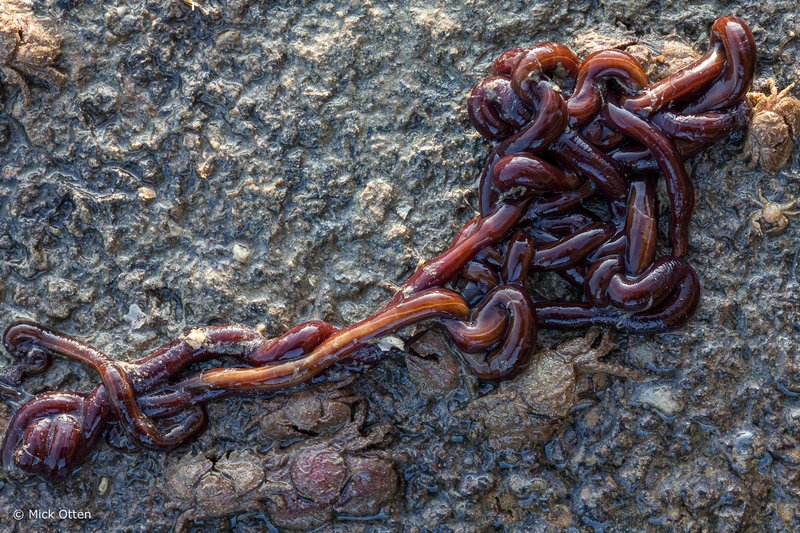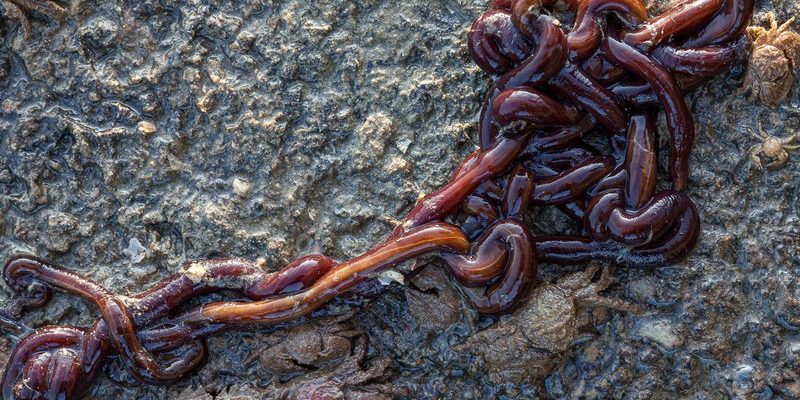
Think of UV light as a special flashlight for science enthusiasts. Unlike standard light, UV light reveals things hidden from the naked eye—and that includes the shiny, glimmering mucus trails of bootlace worms. With a bit of gear and some patience, you’ll be able to track these amazing creatures as they move through their environment. So, grab your UV flashlight, and let’s embark on this unique discovery together!
What Are Bootlace Worms?
Bootlace worms, or *Lineus longissimus*, are among the longest animals on Earth. They can reach staggering lengths of up to 55 meters! These fascinating creatures are often found in coastal regions, usually hiding in mud or sand. They’re called bootlace worms because if you were to find one, it would probably look like a long, twisted shoelace, and yes, they’re quite slippery!
These worms are more than just long; they have a unique way of moving through their habitats. They secrete a mucus trail as they crawl, which helps them glide smoothly across surfaces. The mucus isn’t just for show, though—it plays a critical role in their survival by providing moisture and aiding in feeding.
You might be wondering what makes these worms so interesting to scientists and curious explorers alike. Well, their mucus trails contain valuable information about their behavior, habitat, and even interactions with other creatures. This is where UV light comes in handy!
How Does UV Light Work?
Before we get into the practicalities of using UV light, let’s break down how it works. **Ultraviolet (UV) light** is a type of electromagnetic radiation, just like visible light but with a shorter wavelength. Because of this, UV rays can illuminate certain substances, making them glow in a dazzling display.
When it comes to bootlace worms, this glow comes from their mucus. The proteins and secretions in the mucus react to the UV light, revealing a bright trail against the darker background of mud or sand. It’s like turning on a giant neon sign that tells you exactly where the worms have been!
You may have seen UV lights used in different applications, like detecting counterfeit money or even checking hotel cleanliness. In our case, using a UV light to find bootlace worm trails turns a simple outing into an exciting adventure. Just think of it as being an amateur scientist on a treasure hunt!
Gathering Your Supplies
To successfully use UV light to locate bootlace worm mucus trails, you’ll need a few essential items. Here’s what you should gather:
- UV Flashlight: Look for one that emits light in the 365 to 405 nm range for optimal results.
- Gloves: Protect your hands when handling sand or mud, as well as the worms if you plan to examine them closely.
- Notebook and Pen: Jot down your findings or sketch your adventure as you go along!
- Camera (optional): Capture the moments and trails you discover.
Once you have your gear ready, you’re on your way to uncovering the hidden world of bootlace worm trails. It’s like gearing up for an expedition where each find comes with a sense of wonder!
Finding the Perfect Location
Now that you have your supplies, it’s time to hit the field! Not all places are created equal when it comes to finding bootlace worms. The best spots to find these creatures are coastal areas, marshlands, or estuaries where the water meets the land. Look for sandy or muddy spots; that’s where the worms love to hang out.
Timing plays a significant role in your adventure as well. The best time to search is during low tide when more of the shore is exposed. It’s also less messy, allowing for better visibility. As you walk along the shoreline, keep your eyes peeled for any signs of worms—those slick, shiny mucus trails are often a giveaway.
Once you’ve settled on a spot, it’s time to shine your UV light. Make sure you keep your flashlight steady to get a clear view of those enticing trails. You might feel like a detective solving a nature mystery!
Using the UV Light Effectively
With your UV flashlight in hand, it’s time to put your plan into action. Here are some tips for getting the most out of your search:
1. **Adjust Your Angle:** Shine the UV light at different angles to see which position highlights the mucus trails best. Sometimes, the right angle will make all the difference in visibility.
2. **Move Slowly:** The key to locating those trails is to take your time. Rushing will cause you to miss important details. A slow and steady approach will help you spot more trails.
3. **Check the Surroundings:** Don’t just focus on the shore—look at nearby rocks and vegetation. Bootlace worms might create trails in various spots, so keep your eyes open!
4. **Stay Observant:** Look for changes in texture or shine. The mucus might look different depending on the surface it’s on, so being attentive is crucial.
Just imagine the thrill of spotting a glow that reveals the path of these incredible creatures. It’s like finding hidden artwork in nature!
Understanding the Significance of Mucus Trails
So, why should you care about these mucus trails? Well, they tell a story about the worms and their environment. By studying these trails, scientists can learn about the bootlace worm’s behavior, feeding patterns, and interactions with other species.
For example, if you observe a lot of trails in one area, it might indicate a high population density. Alternatively, if you see fewer trails, there could be factors affecting their movement, like changes in water quality or habitat disruption.
The trails also serve as a vital food source for other animals. Birds, crabs, and fish often follow these trails to find their next meal. By understanding the ecosystem around bootlace worms, we can appreciate the delicate balance of nature.
What to Do After Your Adventure
After a day of exploring and discovering, you might find yourself excited to share your findings! Whether it’s with friends, family, or fellow nature enthusiasts, here are a few ideas:
– **Share Your Photos:** If you took pictures, post them online or create a scrapbook of your experience. It’s a great way to spread the word about these amazing creatures.
– **Document Your Observations:** Write down what you observed, including the location, the number of trails, and anything else that stood out to you. This data can contribute to citizen science projects or simply enhance your knowledge.
– **Explore Further:** If you enjoyed this activity, consider studying more about marine ecosystems or even becoming involved in conservation efforts. Bootlace worms might just be the start of your journey into the wonders of nature!
By taking these small steps, you can help raise awareness about bootlace worms and their habitat. Who knows, you might inspire others to join in on the fun!
Using UV light to locate bootlace worm mucus trails is not just about spotting cool slime in the sand. It’s about diving into the hidden corners of our natural world and uncovering stories that many people overlook. With a little curiosity and the right tools, you can become part of a community that appreciates and learns from these remarkable creatures.
So next time you’re near the coast, grab your UV flashlight and put your newfound knowledge to the test. You might just discover a world filled with magic, wonder, and the slippery trails left behind by bootlace worms. Happy exploring!

